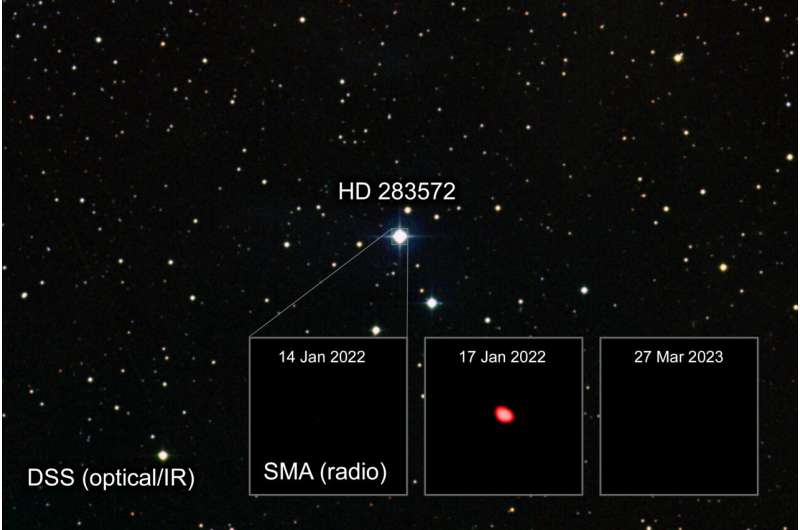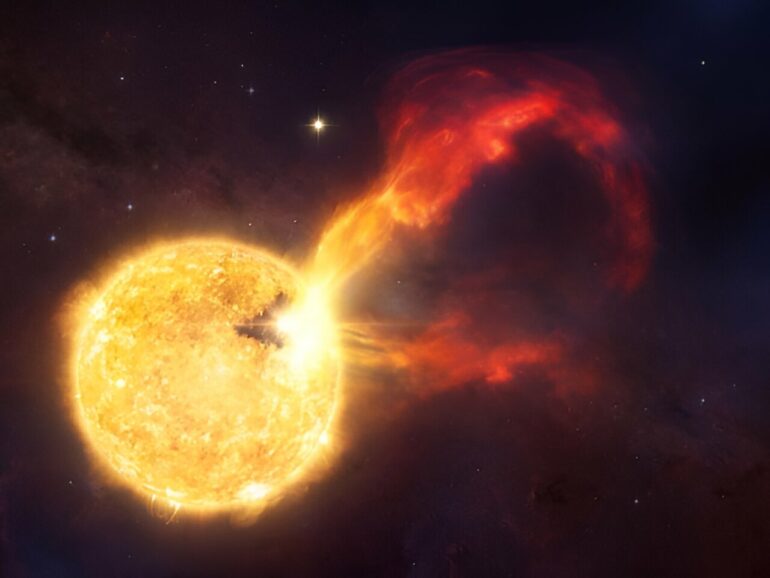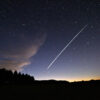Astronomers have detected an extreme eruption from a young star that became more than a hundred times brighter in only a few hours. This discovery offers new insight into how young sun-like stars behave early in their lives, and their impact on the development of any of their newborn planets.
Researchers at the Smithsonian Astrophysical Observatory (SAO), part of the Center for Astrophysics | Harvard & Smithsonian (CfA), led this discovery using Submillimeter Array (SMA) observations of HD 283572, a star 40 percent more massive than the sun located about 400 light-years away. The SMA is an array of telescopes on Mauna Kea in Hawaii that is specifically designed to detect millimeter-wave light.
At less than 3 million years old, HD 283572 is over a thousand times younger than the sun, at the age when Earth-like planets begin to form around stars. A team led by Dr. Joshua Bennett Lovell, an SAO astronomer and SMA Fellow at CfA, was using the SMA to search for the dusty material produced in the formation of young planets that have a faint but detectable glow at millimeter, or radio, wavelengths. However, they found something altogether different.
“We were surprised to see an extraordinarily bright flare from an ordinary young star,” said Lovell. “Flares at these wavelengths are rare, and we had not anticipated seeing anything but the faint glow of planet-forming dust.”
Stellar flares can increase a star’s brightness by factors of tens or hundreds at different wavelengths of light. As stars rotate, their magnetic fields can wind up and develop regions of increased magnetic energy. Like a spring wound too tight, this stored magnetic energy eventually must be released. In the case of stars, this produces intense accelerations of charged particles, which blast through their surfaces.
A challenge for observing such flares is that it is never precisely clear when a star might flare next, and catching them can be particularly challenging at millimeter wavelengths.
“HD 283572 appeared dormant for months before we caught its eruption,” said Lovell. “Every time we pointed the SMA back at the star after this flare, we saw nothing. Our findings confirm that these flare events are rare at millimeter wavelengths but that these can be extremely powerful for stars at this young age.”

Images of the young star HD 283572 and its surrounding field. The large image shows optical and infrared data from the Digitized Sky Survey (DSS), and HD 283572 is the bright star near the middle of the image, highlighted by a square. The insets show Submillimeter Array (SMA) images centered on HD 283572 taken on January 14th and 17th, 2022 and March 27th, 2023. The red source in the middle panel shows the flare witnessed on January 17th. The star was not detected by the SMA on the other two days, nor in five other SMA observations not shown here. The DSS image is 20 arcminutes across (2.3 light-years at HD 283572’s distance of 400 light-years) and the SMA images are 24 arcseconds across. © CfA/J. B. Lovell et al.
The team measured the energy of HD 283572’s flare and found that over a 9-hour period, it released roughly a million times more energy than any millimeter flares seen on the sun’s closest stellar neighbors. This ranks among the most powerful such flares reported.
This was an immense event, equivalent to expending Earth’s entire nuclear arsenal in about a millisecond, over and over again, for nearly half a day!” said SAO researcher Dr. Garrett Keating, second author on the study and SMA Project Scientist. “If we account for the wavelengths of the star’s light that the SMA did not observe, we expect it could have even been many times more energetic.”
With only one flare detected, however, it remains unclear exactly what triggered the event.
“It’s a real puzzle, and there are a range of mechanisms that could be at play. Interactions with unseen companion stars or planets or periodic starspot activity are two possibilities, but what remains beyond doubt is how powerful an event this was,” said Keating. “Any potential planets developing in this system would have been hammered by the intense power of this flare. I wouldn’t want to grow up there!”
The young age of the star and its sun-like nature provide essential clues about the typical environments that any young, developing planet such as the Earth may experience. Powerful flares can limit the growth of planet atmospheres or severely damage atmospheres that have already developed.
Further observations are ongoing to understand how frequently HD 283572 undergoes flaring activity and whether flares around this type of young star inhibit the growth of planetary atmospheres.
“We’re running a new SMA campaign right now to study young stars similar to HD283572. How often do they flare, and what are their typical properties? By combining SMA data with longer wavelength observations, we are also able to probe the physics of flares and their emission mechanisms. I have worked on that using archival data from the Very Large Array,” said Ramisa Akther Rahman, an undergraduate Senior from the College of William and Mary, who was a 2023 summer intern with Dr. Lovell in the SAO’s Research Experience for Undergraduates program.
The results are published in The Astrophysical Journal Letters.
More information:
Joshua Bennett Lovell et al, SMA Detection of an Extreme Millimeter Flare from the Young Class III Star HD 283572, The Astrophysical Journal Letters (2024). DOI: 10.3847/2041-8213/ad18ba
Provided by
Harvard-Smithsonian Center for Astrophysics
Citation:
Extreme eruption on young sun-like star signals savage environment for developing exoplanets (2024, February 6)



